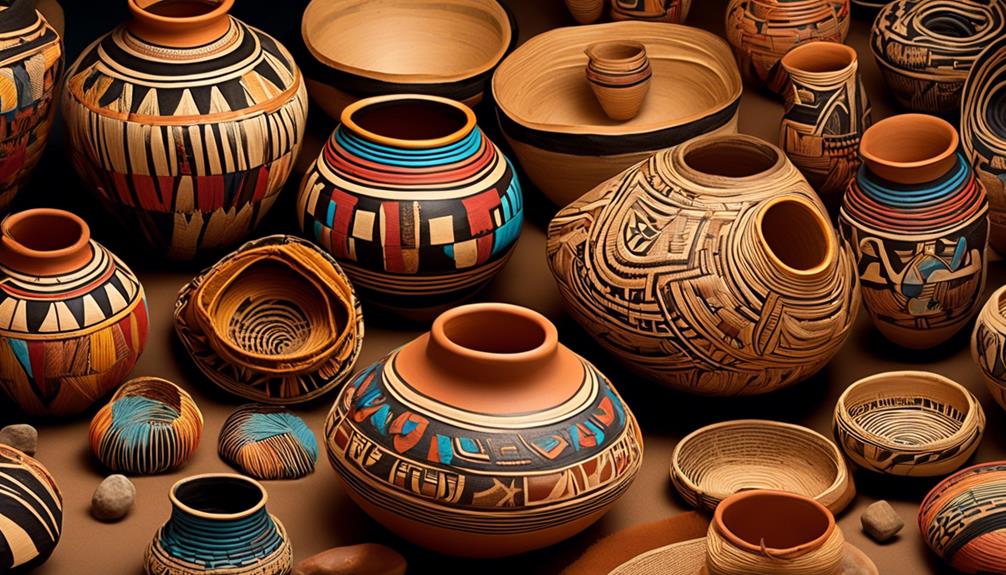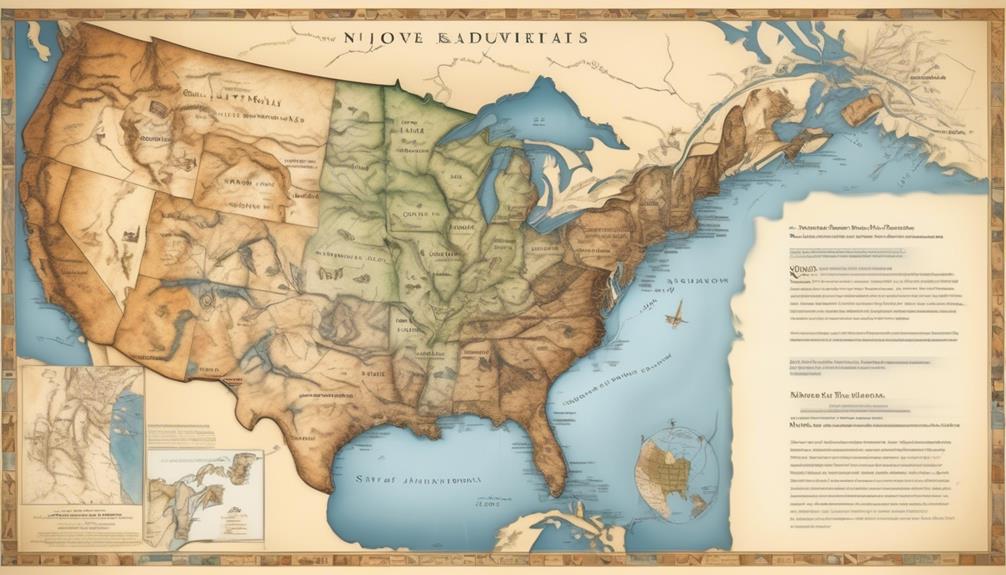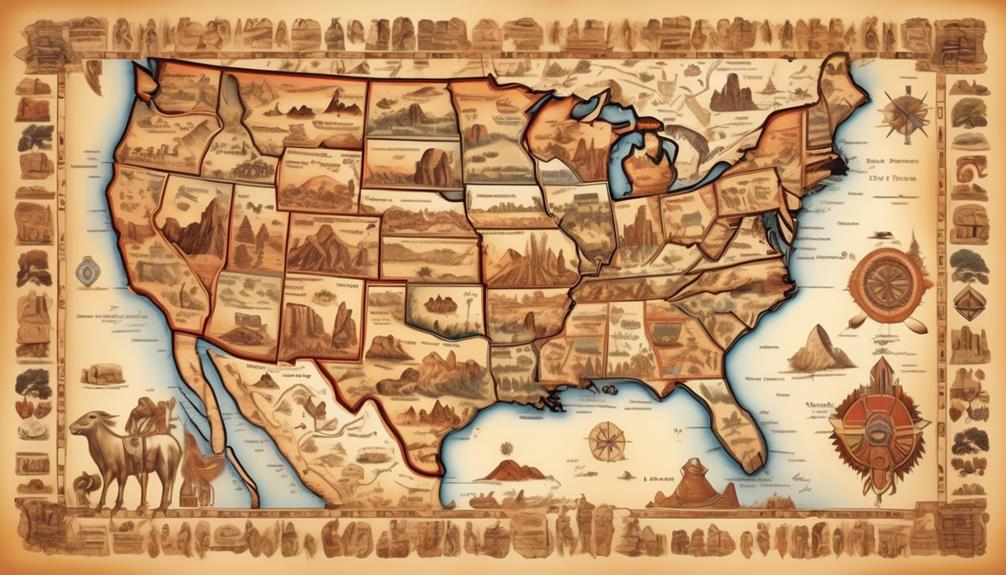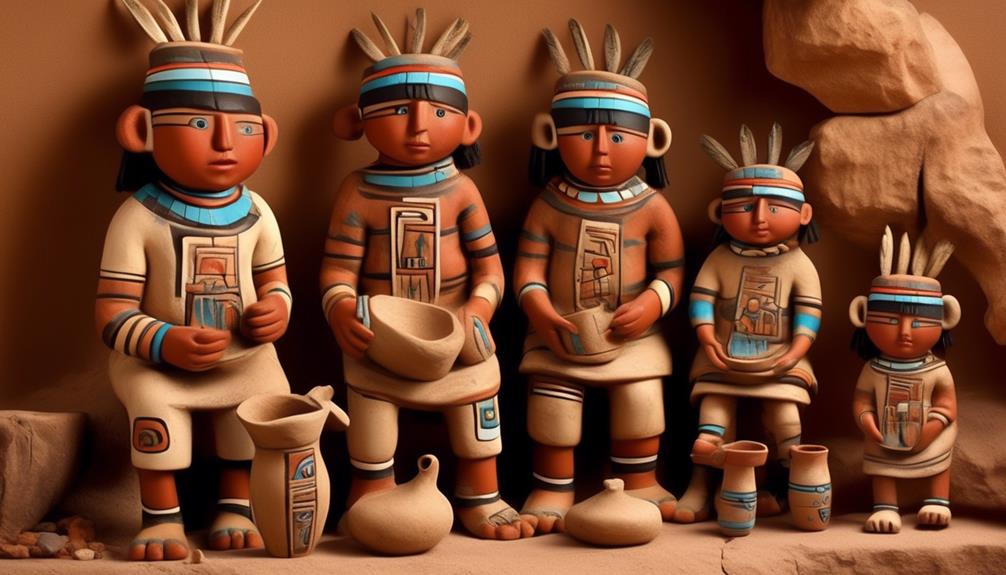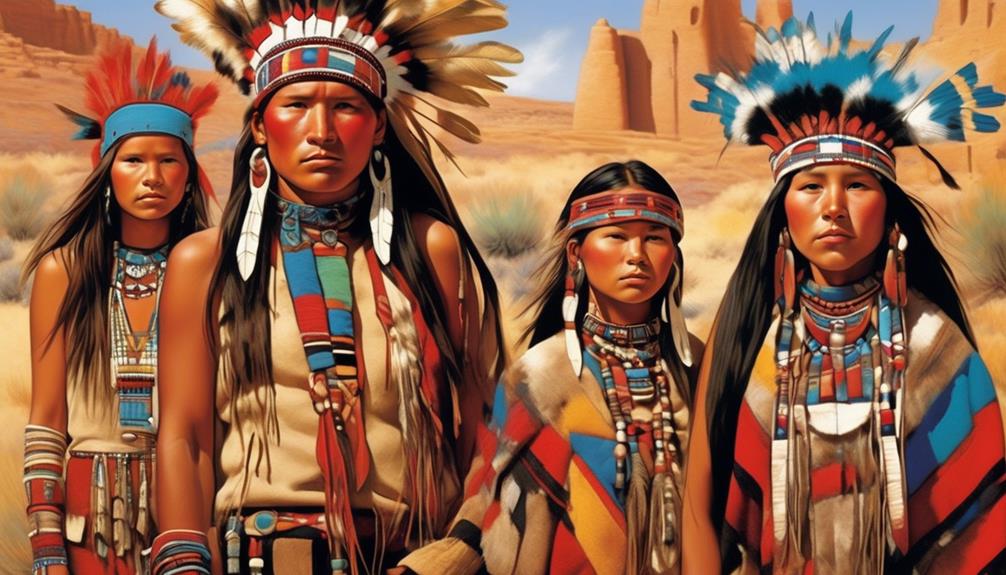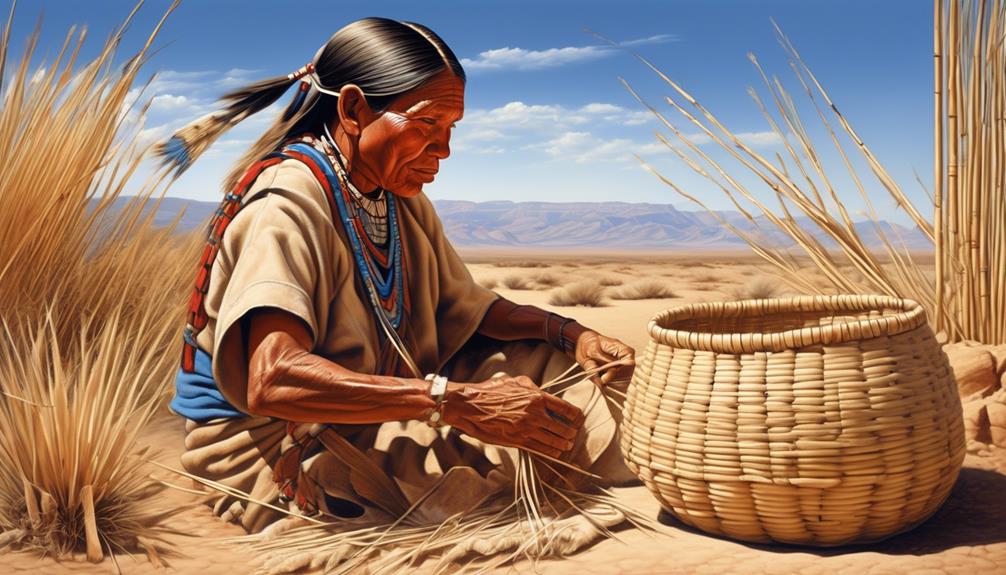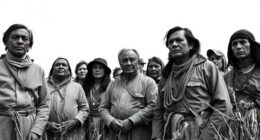In a way akin to a tapestry woven from the elements of the earth, the Hopi tribe depended on an array of natural resources to sustain their customary way of life.
From the sustenance of plants and animals to the raw materials for their crafts and ceremonies, the Hopi people's deep connection to the land is evident in the myriad ways they harnessed the gifts of the earth.
The intricate interplay between the tribe and their environment offers a fascinating glimpse into a way of life that is both ancient and enduring, providing valuable insights into the sustainable practices of the past that continue to resonate in the present day.
Key Takeaways
- The Hopi Tribe utilized desert prickly pear, mesquite beans, and amaranth seeds as sources of food and medicine, demonstrating their sustainable foraging practices and deep connection to the land.
- They extracted clay with unique properties for pottery making and used iron oxide and manganese for pigments, showcasing their deep understanding and respect for the natural world.
- The Hopi Tribe employed hunting techniques and practiced sustainability in their hunting practices, while also utilizing animal skin for clothing, reflecting their intimate connection with the natural world and practical wisdom passed down through generations.
- They implemented water conservation and traditional irrigation techniques for agriculture, and water held spiritual significance in ceremonies, symbolizing renewal and interconnectedness. Their careful management of water reflected their understanding of the natural world.
Plants for Food and Medicine
What plants do the Hopi tribe traditionally use for food and medicine, and how do they prepare and utilize them?
The Hopi tribe has a deep understanding of herbal remedies and traditional knowledge, utilizing a variety of plants for both food and medicine. One such plant is the desert prickly pear, which provides not only a delicious fruit but also medicinal properties. The Hopi people harvest the fruit and use it to make a syrup that's believed to have healing effects on the digestive system.
Additionally, the Hopi have long relied on wild edibles such as mesquite beans and amaranth, using sustainable foraging practices to ensure the continued availability of these important food sources. The mesquite beans are ground into flour, which is then used to make bread and porridge, while amaranth seeds are collected and ground into a nutritious flour.
These traditional practices reflect the Hopi tribe's deep connection to the land and their commitment to utilizing natural resources in a sustainable and respectful manner.
Minerals for Pottery and Pigments

Having explored the traditional uses of plants for food and medicine, the Hopi tribe also harnesses various minerals for pottery and pigments, demonstrating their profound connection to the land and the diverse resources it provides. Mineral extraction is a meticulous process deeply ingrained in the Hopi culture. Clay, a fundamental material for pottery, is extracted from specific locations, each with its unique properties, to achieve the desired characteristics in the final product. The Hopi people have perfected the art of combining different clays to create pottery that is both durable and aesthetically pleasing.
| Minerals | Usage |
|---|---|
| Clay | Pottery making |
| Iron oxide | Red and yellow pigments |
| Manganese | Black pigments |
The traditional pigments obtained from minerals like iron oxide and manganese are used in intricate designs and paintings on pottery, as well as for ceremonial body paints. Iron oxide provides vibrant red and yellow hues, while manganese offers deep black shades, both crucial for expressing the spiritual and cultural symbolism within Hopi art. The intricate knowledge of mineral properties and their application in pottery and pigments exemplifies the Hopi tribe's profound understanding and respect for the natural world.
Animals for Food and Clothing
The Hopi tribe skillfully utilize various animals for sustenance and clothing, embodying their intimate connection with the natural world and the practical wisdom passed down through generations. Our hunting techniques are steeped in sustainability, respecting the balance of nature and ensuring the continued abundance of animal populations. We hunt rabbits, deer, and quail, employing a combination of traps, snares, and bows and arrows to secure our food and materials for clothing.
- Hunting Techniques:
- We use traps and snares to catch small game like rabbits and quail, ensuring minimal impact on the surrounding ecosystem.
- For larger game such as deer, we employ skilled archers to ensure a swift and respectful hunt.
- Sustainability:
- We closely monitor and regulate our hunting practices to avoid overexploitation of animal populations, ensuring their continued presence in our lands.
Our use of animal skin for clothing involves a meticulous tanning process. We carefully remove the fur or feathers and then tan the hides using natural materials like tree bark and plant extracts, resulting in durable and weather-resistant clothing that serves us well in our desert environment.
Water for Agriculture and Ceremonies

Utilizing the vital resource of water, we cultivate our crops and honor traditional ceremonies, embodying our deep reverence for the natural elements that sustain our way of life. Water conservation techniques and traditional irrigation have been integral to our agricultural practices for centuries. Through the skillful use of irrigation canals and terraced fields, we maximize water efficiency, allowing us to grow our staple crops such as corn, beans, and squash in the arid desert landscape. Our ancestors developed ingenious methods to capture and distribute water, enabling sustainable agriculture in an environment with scarce water resources.
Water holds profound spiritual significance in Hopi ceremonies. It's revered as a life-giving force and is essential for the well-being of our community. During rituals and dances, water is used to cleanse and purify both the participants and the ceremonial space. Its presence symbolizes renewal, fertility, and the interconnectedness of all living beings.
The careful management of water for both practical and ceremonial purposes reflects our deep understanding of the natural world and our commitment to preserving the balance between human activities and the environment.
Natural Materials for Construction and Crafts
Incorporating natural materials such as clay, wood, and fibers, the Hopi tribe demonstrates a deep connection to the environment through their construction and crafting practices.
- Sustainable building: The Hopi people utilized locally sourced clay to construct their traditional adobe houses, known as 'pueblos,' which provided natural insulation and helped regulate indoor temperatures.
- Traditional craftsmanship: Skilled artisans crafted intricate pottery using clay sourced from the surrounding landscapes, showcasing the tribe's expertise in pottery making and their reverence for the earth's resources.
- Woodworking: The Hopi tribe utilized timber from nearby forests to construct various items such as tools, furniture, and ceremonial objects, showcasing their resourcefulness and respect for the natural world.
- Fiber arts: Utilizing plant fibers, such as yucca and cotton, the Hopi people created beautifully woven baskets, textiles, and ropes, showcasing their mastery of traditional craftsmanship and sustainable use of natural materials.
The Hopi tribe's use of natural materials for construction and crafts not only reflected their sustainable building practices but also highlighted their deep understanding of traditional craftsmanship, emphasizing their harmonious relationship with the environment.
Frequently Asked Questions
How Did the Hopi Tribe Use Natural Resources in Their Spiritual Ceremonies and Rituals?
In our spiritual practices, the Hopi Tribe utilized a variety of natural resources to connect with the spiritual world. We carefully selected specific plants, minerals, and elements from the environment to create ceremonial items and tools.
These resources were used to invoke spiritual energy, healing, and blessings during our rituals. The deep reverence for nature and the intentional use of natural elements enhanced the sacredness of our ceremonies and strengthened our spiritual connections.
What Specific Plants Did the Hopi Tribe Use for Dyes and Pigments in Their Pottery and Artwork?
We used plant-based colors derived from natural dyes for pottery pigments and artwork pigments.
The Hopi tribe utilized specific plants to create vibrant dyes and pigments for their pottery and artwork. These natural resources were vital in expressing our cultural identity through intricate designs and symbols.
The use of plant-based colors reflected our deep connection to the earth and the importance of sustainable practices in our artistic traditions.
What Traditional Methods Did the Hopi Tribe Use to Hunt and Gather Animals for Food and Clothing?
Traditional techniques and knowledge passed down generations guided our hunting and gathering practices. We utilized respectful and sustainable methods to procure food and clothing, honoring the spiritual significance of the natural resources.
Our clothing production intertwined with ceremonial use, and we harnessed water sources for agricultural practices. Our deep connection to the land and its resources shaped our traditional construction and water management, reflecting our reverence for the earth.
How Did the Hopi Tribe Use Natural Materials for Constructing Their Traditional Dwellings, Such as Adobe and Pueblos?
Using natural building materials, the Hopi tribe constructed their traditional dwellings, such as adobe and pueblos. The adobe construction and pueblo architecture were integral to their lifestyle, blending with the environment and providing sturdy, sustainable homes.
Natural resources like clay, sand, and water were utilized, showcasing the tribe's mastery of traditional building techniques. The resulting dwellings reflected the deep connection between the Hopi people and the land they inhabited.
What Role Did Water Play in the Agricultural Practices of the Hopi Tribe, and How Did They Harness Natural Water Sources for Their Crops?
Harnessing water was central to our agricultural practices. We utilized natural water sources ingeniously, building a network of irrigation canals to channel water to our crops. The intricate system allowed for efficient distribution, essential for sustaining our agricultural livelihood.
Harnessing water was a testament to our resourcefulness and deep understanding of the land. Our agricultural practices were a harmonious dance with nature, ensuring the prosperity of our crops.
Conclusion
So, as we can see, the Hopi tribe used a variety of natural resources for their everyday needs.
It's ironic how modern society often overlooks the importance of these natural elements and instead relies heavily on artificial and manufactured products.
Maybe we can learn something from the Hopi and find a way to reconnect with the earth, appreciating and utilizing its gifts in a more sustainable and harmonious way.
